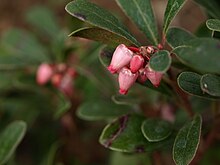Bearberry
Unlike the other species of Arctostaphylos (see manzanita), they are adapted to Arctic and subarctic climates, and have a circumpolar distribution in northern North America, Asia and Europe.
[1] In the culture of First Nations people of Canada, the plant is called kinnikinnick, from an Algonquian (possibly a Blackfoot) word for "smoking mixture".
[1] The plant has flexible branches growing up to 2 metres (6 ft 7 in) long covered with red, shredded bark and dark green, oval leaves.
[5] Bearberry appears to be relatively safe, although large doses may cause nausea, vomiting, fever, chills, back pain and tinnitus.
[5][7] The efficacy and safety of bearberry treatment in humans remain unproven,[6] as no clinical trials exist to interpret effects on any disease.
[citation needed] Native Americans use bearberry leaves with tobacco and other herbs in religious ceremonies, both as a smudge (type of incense) or smoked in a sacred pipe carrying the smoker's prayers.
[1] Among the ingredients in kinnikinnick were non-poisonous sumac leaves,[8] and the inner bark of certain bushes such as red osier dogwood (silky cornell),[8] chokecherry, and alder, to improve the taste of the bearberry leaf.



